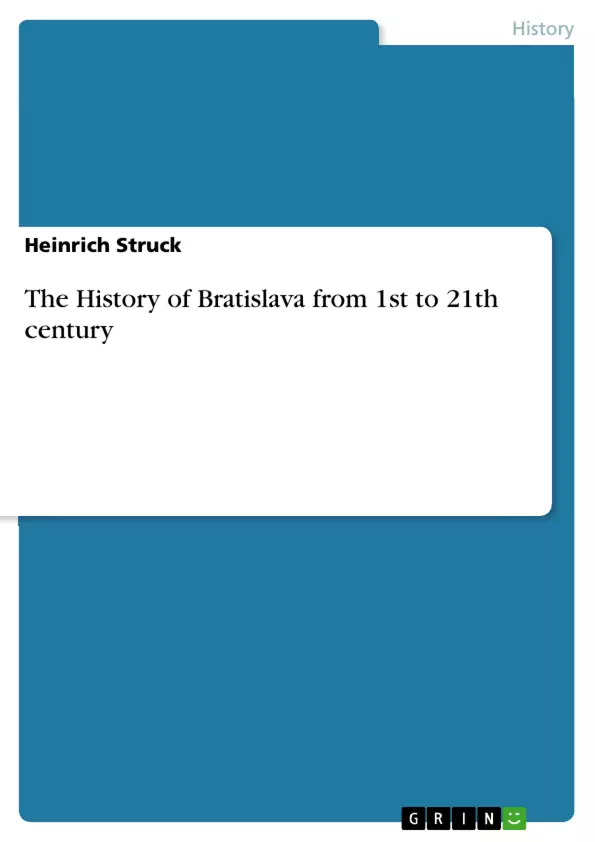This paper deals with the history of Bratislava from 1st century until 21st century.
1. 1st - 10th century
2. First Hungarian age
3. The beginning of Habsburg epoch
4. The uprisings an Napoleonic time
5. First Czechoslovak Republic
6. Bratislava during the world wars
Table of Contents
- 1st - 10th century
- First Hungarian age
- The beginning of Habsburg epoch
- The uprisings and Napoleonic time
- First Czechoslovak Republic
- Bratislava during the world wars
Objectives and Key Themes
This text aims to provide a historical overview of Bratislava from the 1st to the 21st century. It explores the city's development through various periods, highlighting key events and their impact on its political, social, and economic landscape.
- Bratislava's strategic location and its role in regional power dynamics.
- The influence of different empires and rulers on the city's development.
- The evolution of Bratislava's urban landscape and infrastructure.
- Significant historical events and their consequences for Bratislava.
- The changing ethnic composition of Bratislava's population.
Chapter Summaries
1st - 10th century: This chapter details Bratislava's early history, beginning with its existence as a Roman outpost on the Danube frontier (Gerulata) and continuing through the period of Slavic settlement and the rise and fall of Great Moravia. It highlights the strategic importance of the Danube and the role of Bratislava in the conflicts between various empires and tribes. The chapter concludes with the first documented mention of Bratislava Castle in 907, marking a pivotal point in the city's history as it transitioned under Hungarian influence.
First Hungarian age: This section focuses on Bratislava's development under Hungarian rule, beginning in the 10th century. It covers the city's growth as an economic and administrative center, punctuated by periods of conflict and military attacks, notably by King Henry I of Germany. The chapter also examines the arrival of German colonists, who became a significant part of the city's population. The granting of royal privileges to Bratislava and its role in conflicts between Hungary and Bohemia, leading to the First Peace of Pressburg, are key themes. The 14th and 15th centuries saw Bratislava become a prominent political center under Sigismund of Luxembourg, facing challenges from Hussite incursions and grappling with the construction and destruction of bridges over the Danube.
The beginning of Habsburg epoch: This chapter discusses the transition of Bratislava under Habsburg rule, beginning with internal conflicts within Hungary and the battle between King Ladislaus III and Queen Elisabeth. The founding of the Universitas Istropolitana in 1490 represents a significant cultural achievement. The chapter focuses on the pivotal battle of Mohács in 1526 and the subsequent election of Ferdinand of Habsburg as the new King of Hungary in Bratislava. The chapter emphasizes the strategic importance of Bratislava as a refuge for Hungarian nobility fleeing Turkish advances and its eventual ascension to the capital city of Hungary in 1536, a status maintained until 1830.
Keywords
Bratislava, Hungary, Habsburg Monarchy, Great Moravia, Danube River, Roman Empire, German colonists, Hussite Wars, Turkish invasions, Royal city, Capital city, Historical development, Central Europe.
Frequently Asked Questions: A Historical Overview of Bratislava
What is the purpose of this text?
This text provides a historical overview of Bratislava from the 1st to the 21st century, exploring its development through various periods and highlighting key events impacting its political, social, and economic landscape.
What time periods are covered in this historical overview of Bratislava?
The overview covers a broad timeframe, starting from the 1st to the 10th century, then focusing on the First Hungarian Age, the beginning of the Habsburg epoch, the uprisings and Napoleonic times, the First Czechoslovak Republic, and finally Bratislava during the world wars.
What are the key themes explored in this text?
Key themes include Bratislava's strategic location and its role in regional power dynamics; the influence of different empires and rulers on the city's development; the evolution of Bratislava's urban landscape and infrastructure; significant historical events and their consequences; and the changing ethnic composition of Bratislava's population.
What is covered in the chapter on the 1st-10th centuries?
This chapter details Bratislava's early history, starting as a Roman outpost (Gerulata), through Slavic settlement, the rise and fall of Great Moravia, and its transition under Hungarian influence after the first documented mention of Bratislava Castle in 907.
What does the chapter on the "First Hungarian Age" discuss?
This section focuses on Bratislava's development under Hungarian rule, including its growth as an economic and administrative center, conflicts (like those with King Henry I of Germany), the arrival of German colonists, the granting of royal privileges, and its role in conflicts between Hungary and Bohemia.
What is the focus of the chapter on the "Beginning of the Habsburg Epoch"?
This chapter discusses Bratislava's transition under Habsburg rule, including internal Hungarian conflicts, the founding of the Universitas Istropolitana, the Battle of Mohács, Ferdinand of Habsburg's election as King of Hungary, and Bratislava's role as a refuge for Hungarian nobility and its eventual ascension to the capital city of Hungary (1536-1830).
What are the key words associated with this historical overview of Bratislava?
Keywords include Bratislava, Hungary, Habsburg Monarchy, Great Moravia, Danube River, Roman Empire, German colonists, Hussite Wars, Turkish invasions, Royal city, Capital city, Historical development, and Central Europe.
What is the table of contents of this text?
The table of contents includes: 1st-10th century, First Hungarian Age, The Beginning of the Habsburg Epoch, The Uprisings and Napoleonic Time, First Czechoslovak Republic, and Bratislava During the World Wars.
- Arbeit zitieren
- Heinrich Struck (Autor:in), 2008, The History of Bratislava from 1st to 21th century, München, GRIN Verlag, https://www.grin.com/document/117167



